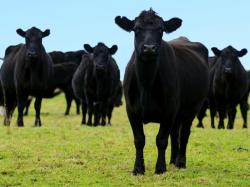Certified Angus Beef – Driving Progress
October 20, 2017 | 3 min to read

Asked what I drive, I might talk about my Chevy pickup… or venture into a less likely intent for that query. On our cattle farm, I drive creative change toward something better.
Eleven years ago in this column, you might say I coined a phrase, or at least brought it into the pens and pastures: the purpose-driven herd, later the title for a blog series.
I looked back 11 years, or 22 years ago now, to the rise of value-based cattle marketing and the growing availability of data to guide our planned progress. Scores of custom feedlots built relationships by sharing feedyard and carcass data, and then consulted with cow-calf customers to help make the next calf crop better.
Since then, DNA-based technology and more accurate data have helped the seedstock sector create bulls for every purpose, but most important is the increasingly common creation of bulls that excel in multiple traits.
In the 1990s, when ranchers saw their first carcass data and the dollars at stake, many tried to improve their herds with a new focus on marbling in bull selection. Some paid a price in other areas and were said to be chasing a dubious goal that could only be attained by sacrificing progress elsewhere.
Consumers wanted more marbling. Scientific study found no reason to create single-trait marbling bulls, because the trait most linked to premium beef production was not much linked to anything else. We really could have it all in one genetic package, though some breeds followed that idea with more success than others.
No matter the segment of the beef cattle production chain, all came to realize consumer demand for better beef was a real and growing force in the market. Price signals spoke loudly so that feedyards and order buyers sorted out sources they wanted to buy from most and least. Ranchers developed better records that ranked cows on more than weaning weights and calving dates.
Widespread drought a few years ago was a catalyst that met emerging, affordable DNA testing among top commercial herd operators, right when calf prices were trending toward all-time highs. In drought-affected herds, it was time to act on production records to cull from the bottom, leaving only the top half or maybe only the top quarter, proven best by records and genomics.
They’d have reached the higher quality plain eventually, but conditions moved things ahead and the rebuilding phase of the cattle cycle that began in 2014 has been called the most purpose-driven expansion in the history of the U.S. cattle business. In 2017, the share of fed cattle reaching Choice and Prime is often 10 percentage points above the most recent five-year average.
We had guided improvement in our own herd for years when we first considered calling it purpose-driven, and that has continued apace. Some might say we’re staying the course, but that means leaving as little to chance as possible and weighing the new options that come along.
What do you drive, and what drives you? We know that transitive verb has many meanings but often relates to change. Our ability to drive it is not universal, hence the prayer asking for serenity to accept that, courage to drive when we can and wisdom to know when we can’t.
The seasons and the weather they bring, the relentless and one-directional passage of time—farmers and ranchers live close to these forces.
With transitions all around us as the leaves fall and spring calves leave their mothers’ side, while some herds start calving, let’s keep thinking about tomorrow and how we can make it better.
Given any chance to influence it, I want to drive.
Next time in Black Ink® Miranda Reiman will look at the everyday miracles around us. Questions? Call 330-465-0820 or e-mail steve@certifiedangusbeef.com.
Source: Certified Angus Beef Brand
